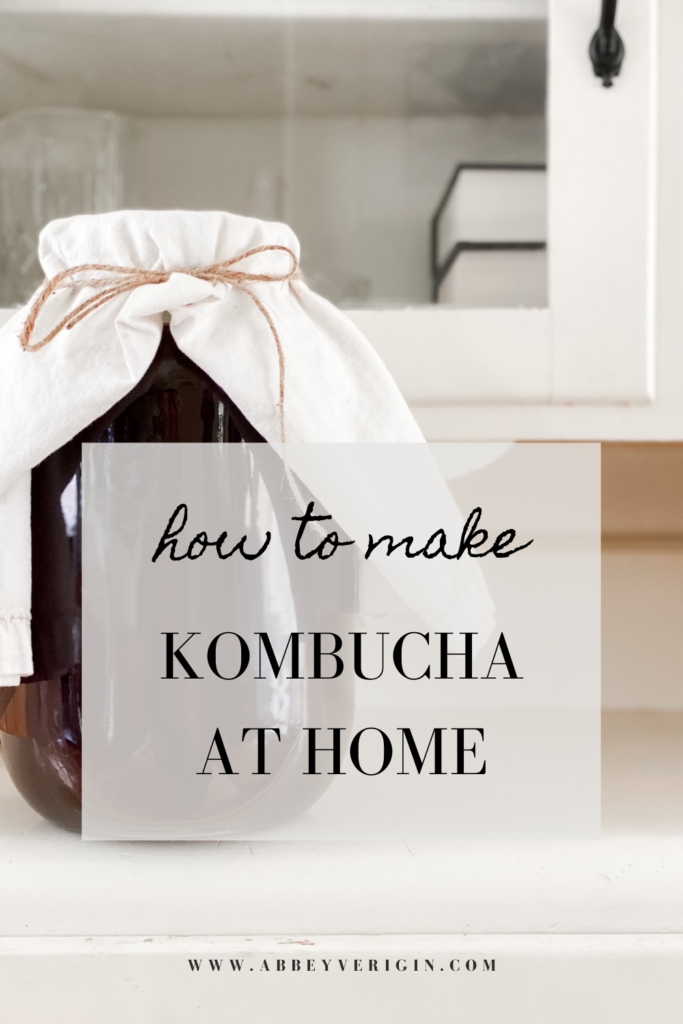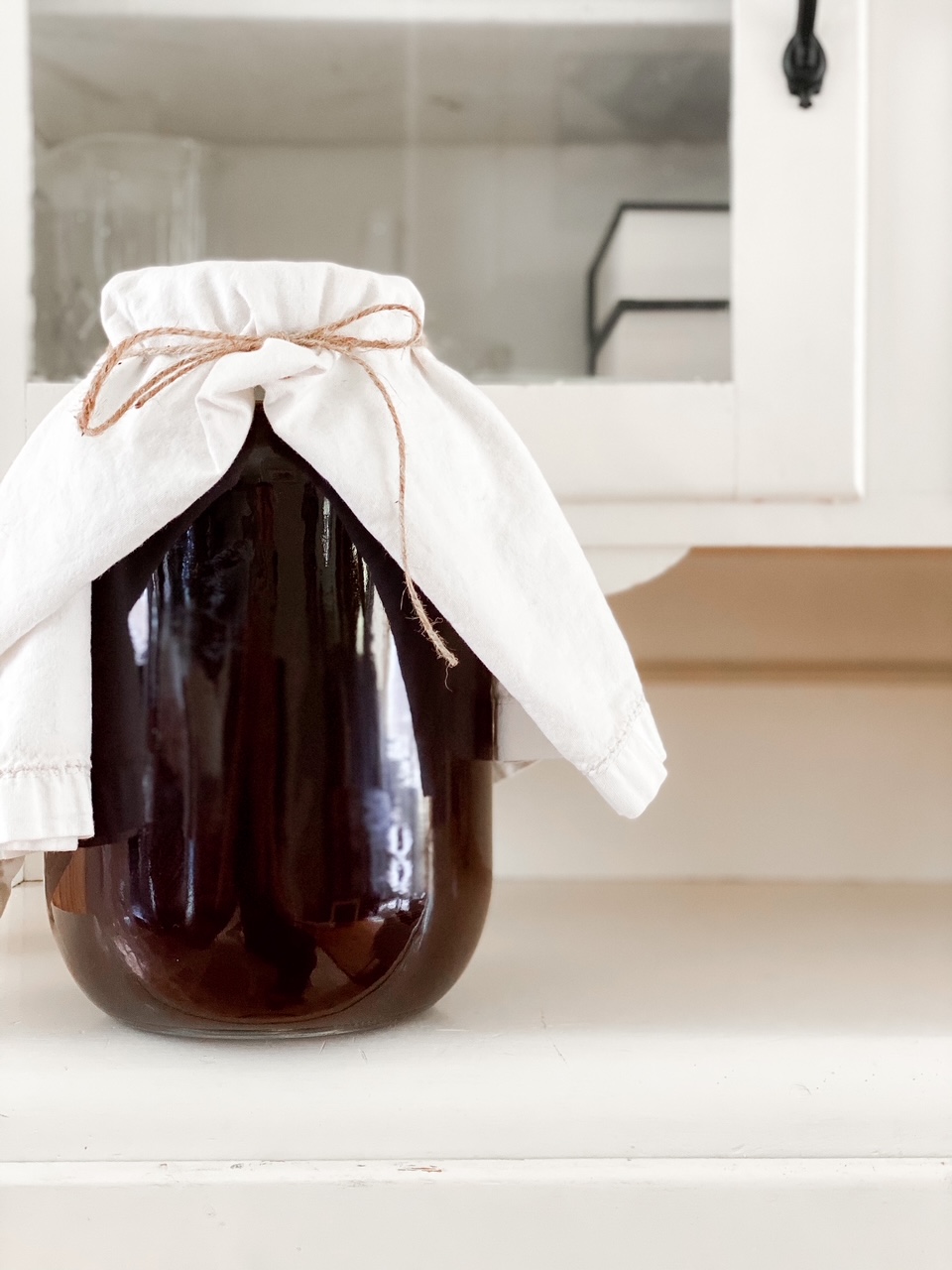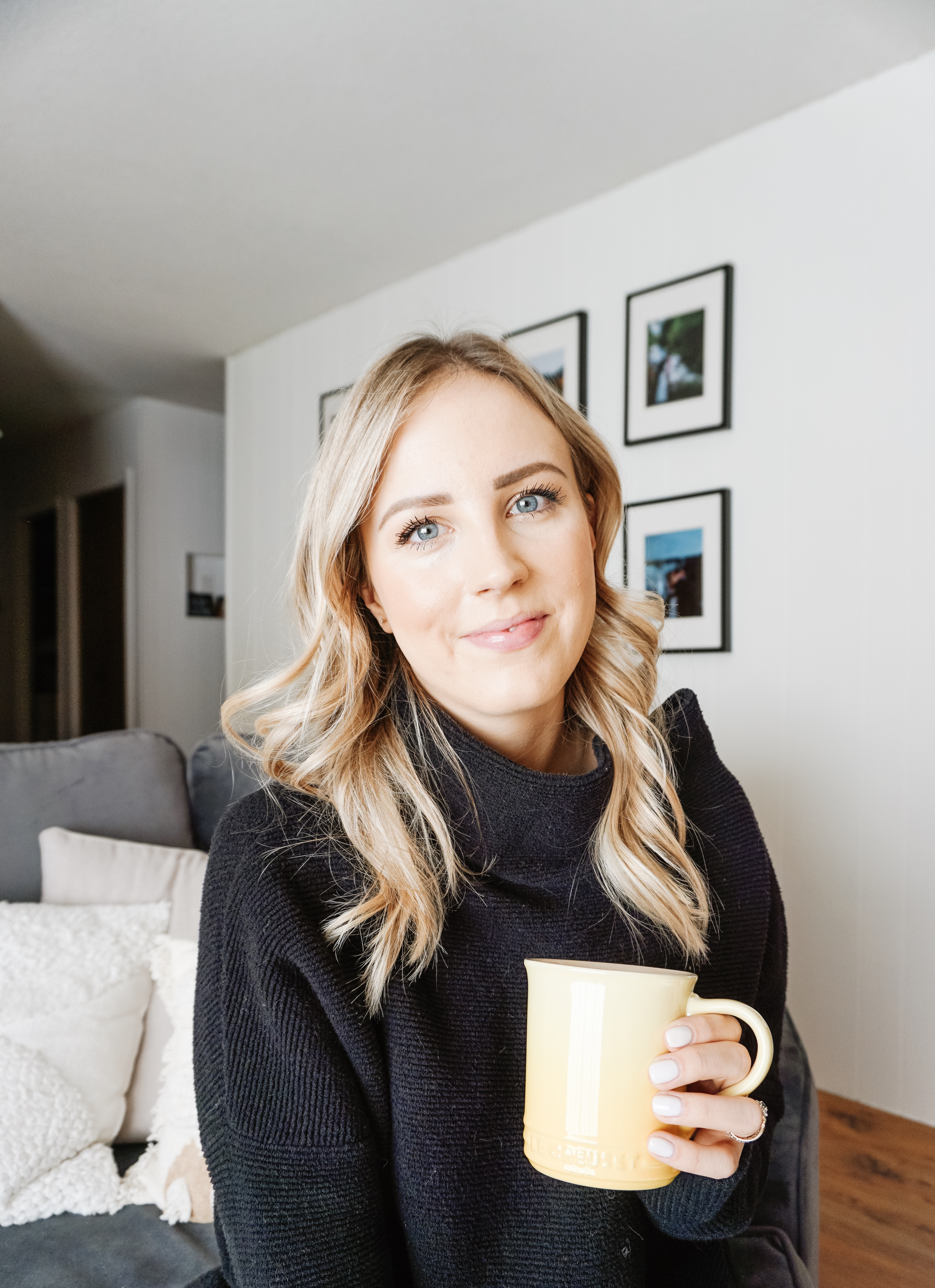Learn how to make kombucha at home. Kombucha is a lightly sweet and carbonated fermented beverage, packed full of probiotics. Black tea, sugar, a SCOBY and kombucha starter is all you need to begin brewing kombucha at home.
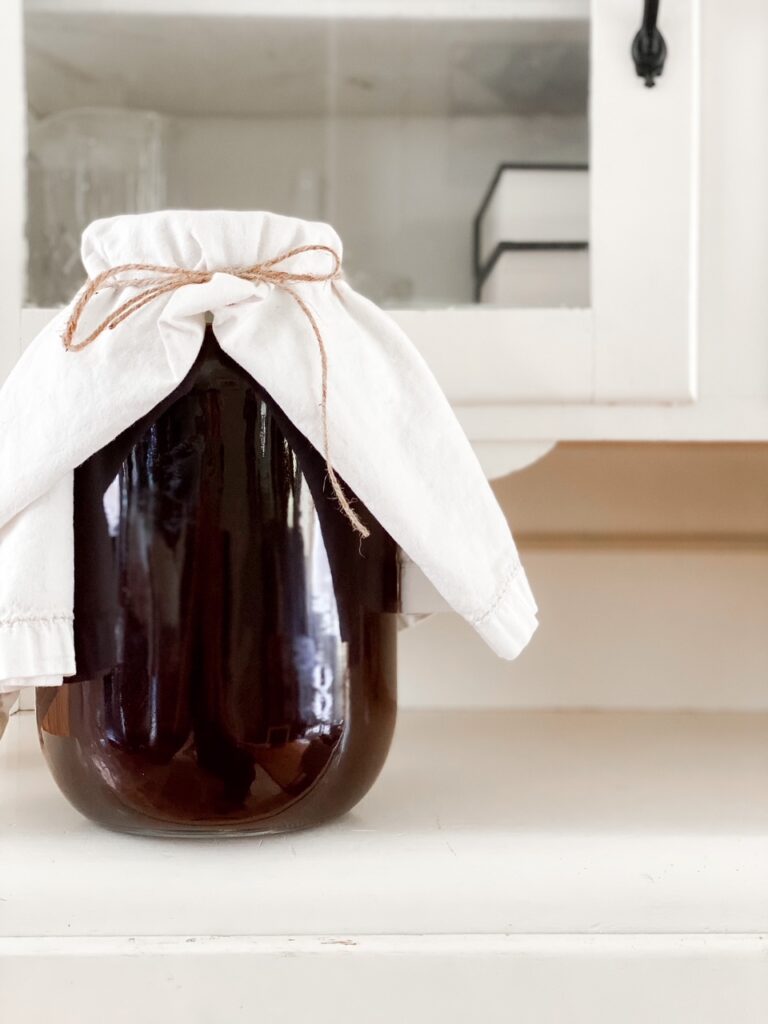
This post contains affiliate links, which means I make a small commission at no extra cost to you. See my full disclosure here.
I have been a long time lover of kombucha. When my store bought kombucha habit really started to pick up about 6 years ago, I knew it was time to start brewing it myself. While a single bottle will set you back almost $5, you can make an entire gallon for less than half of that. Kombucha is a delicious and economical way to get in some probiotics.
Kombucha has gained massive popularity over the last 10 years, and for good reason. Think of kombucha as a probiotic rich, low sugar, naturally carbonated alternative to soda. The idea of making your own can sound a little intimidating, but I promise it is beyond simple and requires very little effort. As it goes with a lot of fermenting, the biggest requirement is time.
What Is Kombucha
Kombucha is a fermented tea that is made with strongly brewed black tea, sugar, a SCOBY, and kombucha starter. Kombucha starts out as a sweet tea mixture which is then fermented by the SCOBY.
What Is A Scoby
A SCOBY is a “symbiotic culture of bacteria and yeast”. The SCOBY essentially feeds off of sugar and caffeine which changes the sweet tea into a slightly sweet, slightly tart, fizzy fermented beverage. The SCOBY is essentially the mother culture that you need to make kombucha. It looks sort of like a jelly fish and forms in a layer at the top of whatever vessel you are brewing kombucha in.
What Are The Health Benefits Of Kombucha
When kombucha is traditionally prepared is packed full of probiotics, enzymes, electrolytes, and acetic acids. Kombucha is great for supporting our gut health, digestion, and immunity.
It’s important to be aware of the kombucha you are buying at the store. These days there are many varieties on the market that are heat processed. This will destroy the probiotics and enzymes, so be aware as these are a big reason most consume kombucha in the first place.
Can You Make Substitutions With Home Brewed Kombucha
When brewing kombucha, the SCOBY feeds off of two things, caffeine and sugar.
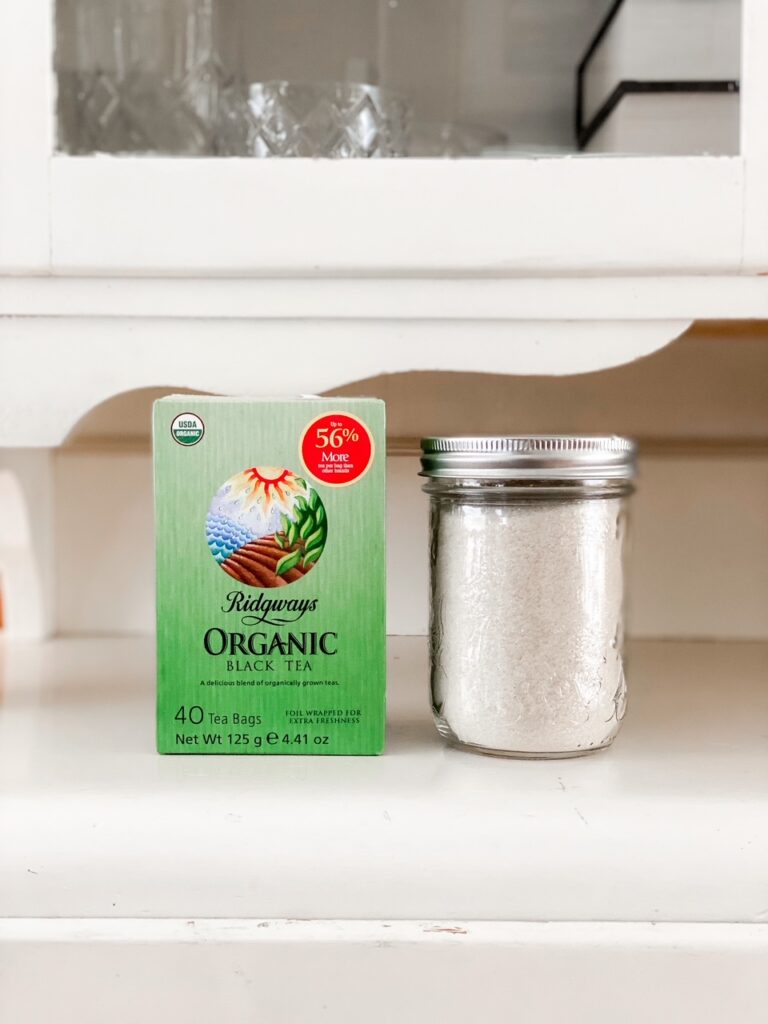
For tea, you can use green tea, white tea, or oolong tea in place of black tea. Caffeine free tea will not work to make kombucha.
It is not possible to make kombucha sugar free. Sugar is required for yeast and bacteria, which is what makes kombucha. This is what creates carbon dioxide which gives kombucha its effervescence. Stevia, xylitol, and monk fruit will not work.
Alternate sugar sources like molasses, honey, agave, and coconut sugar can be used. While these will work, they contain higher mineral content which can make the SCOBY a little sluggish. Unrefined cane sugar like panela and turbinado also work. Ideally, cane sugar is your best option. Using cane sugar gives the most consistent result when it comes to flavor.
Does Kombucha Contain Alcohol
Alcohol is a by product of the natural fermentation process, so while kombucha isn’t typically intended to be an alcoholic beverage, it does contain very small amounts of alcohol. You can control the amount of alcohol by how long you brew kombucha for. The longer that kombucha is brewed, the more alcohol it may contain.
To give you an idea, a strong batch of home brewed kombucha may have an alcohol percentage of 3%. That is a whole percent lower than a light beer. Commercial varieties contain less than 0.5% of alcohol so they can be sold as a non-alcoholic beverage. Some brands have stronger kombuchas that sit around 3%, so they have to be sold as alcoholic beverages. I don’t think alcohol in kombucha is something to be concerned about.
What You Need To Make Kombucha
To make kombucha, you will need a few basic supplies you likely have around your home, plus the ingredients to make the fermented tea.
- Large Pot
- Wooden Spoon
- Gallon Sized Jar
- Cotton Dish Towel or Cheese Cloth
- Black Tea Bags
- Sugar. I find organic cane sugar works best.
- SCOBY & Kombucha Starter. You can make your own, get one from a friend, or purchase one here. The SCOBY comes with kombucha starter, which is just strong brewed kombucha. This is the liquid that the SCOBY is stored in. Every time you make a batch you will keep some aside.
- Water
During the second fermentation, the flavor and carbonation will develop. You will need a few additional tools.
- Flip Top Bottles. While these are ideal for the best results in terms of carbonation, they aren’t necessary! You can reuse old store bought kombucha bottles or even mason jars with lids.
- Fresh Fruit or Fruit Juice. This is to flavor the kombucha on the second ferment.
How To Flavor Kombucha
To flavor kombucha, the options are almost endless! Herbs, fresh fruit, and fruit juices all work to flavor kombucha. Sometimes I will even use vanilla extract. The flavoring and carbonation takes place during the second ferment. You do not want to add flavoring to your initial fermentation because it could damage your SCOBY.
I typically use 1 liter flip top bottles, but you can use mason jars. I don’t usually follow an exact formula, I like to wing it! As a starting point, I like to add to 3 cups of kombucha to a 1 liter flip top bottle. Next, add about 2/3 cup of fresh or frozen fruit. Alternatively, to 3 cups of kombucha I add about 1/3 cup of fruit juice. Just play around with this!
Keep in mind you always want to add a source of sugar in the second fermentation, so the bacteria has something to feed off of. In my case, that is juice or fruit, but if you would like to keep it unflavored, I would add a teaspoon of sugar or honey.
Some of my favorite flavor combinations when making kombucha at home:
- Blueberries and fresh ginger
- Lemon juice, honey, and ginger
- Strawberries and basil
- Blueberries and mint
- Peaches and vanilla
- Peaches and rosemary
The options are endless when flavoring your homemade kombucha!
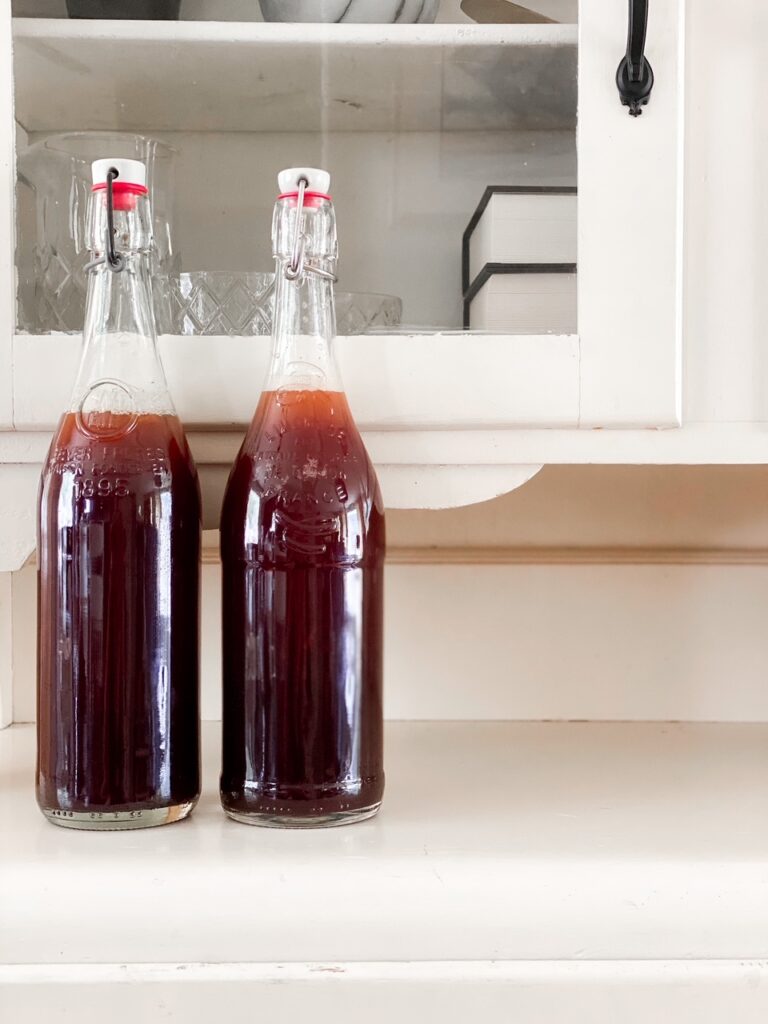
How To Make Kombucha
To make kombucha at home, first start by bringing the water to a boil in a large pot. Once boiling, remove the pot from the heat and stir in the sugar. Add the tea bags and cover with a lid. Allow to sit until the sweet tea mixture has come to room temperature. This step is crucial, because you could kill the kombucha starter and SCOBY by adding them to hot tea.
Next, add the sweet tea mixture to your gallon sized glass jar. Carefully add the SCOBY and starter culture. If the sweet tea mixture is a different temperature than the SCOBY, it may sink a little bit. Once they reach the same temperature, it will float to the top.
Cover the jar with a double layered piece of cheese cloth or a dish towel and secure with a rubber band or twine. Alternatively, coffee filters also work for this. The goal is to allow the kombucha to breathe without letting in any bugs. Allow the kombucha to ferment anywhere from 7-21 days. Yes, this is a range, but kombucha will ferment slower in cold temperatures and faster in hot. When it is ready to bottle, it will be slightly sweet and tart.
When the kombucha is ready to bottle, add any fruit or juice to the flip top bottles for flavoring. Transfer the kombucha to flip top bottles leaving a few inches of head space so the CO2 can move around. Keep aside at least 2 cups or more of kombucha, so you have some to store your SCOBY in and use in your next batch. Transfer the SCOBY to the fridge, or start a new batch following the same instructions. A new SCOBY will form on the top of your fermentation vessel.
The bottled kombucha is now ready for its second ferment. Let the sealed flip top bottles to sit on the counter for 1-3 days until carbonated. The kombucha will continue to feed off of the sugar. Finally, remember to crack the bottles once a day so that some of the CO2 can escape. While we want the kombucha to carbonate, we also want to avoid any explosions. I have skipped this step before and as a result had raspberry kombucha all over our ceiling – it was not a fun mess to clean up.
Your kombucha is ready to go! Store in the fridge so that the fermentation process is slowed.
How To Make Kombucha At Home
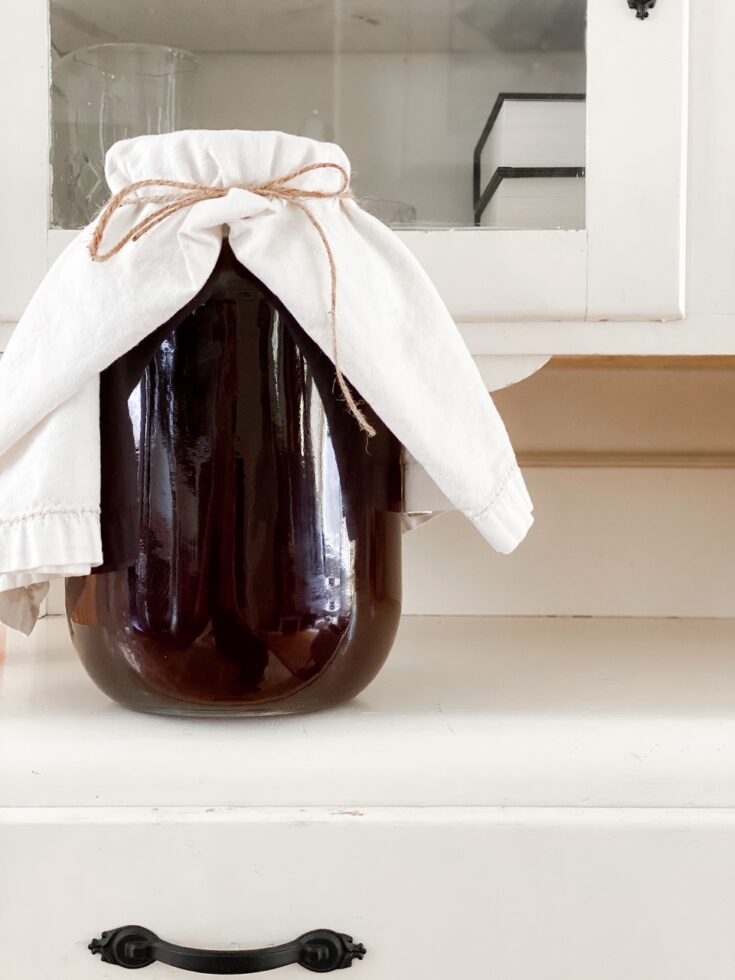
Learn how to make kombucha at home. Kombucha is a lightly sweet and carbonated fermented beverage, packed full of probiotics. Black tea, sugar, a SCOBY and kombucha starter is all you need to begin brewing kombucha at home.
Ingredients
- 14 cups of filtered water
- 1 cup organic cane sugar
- 8 bags organic black tea
- 2 cups strong brewed kombucha (kombucha starter)
- 1 SCOBY
- gallon sized glass jar
- dish towel or cheese cloth
- elastic or twine
- 5 1 liter flip top bottles
- fruit, fruit juice, or herbs for flavoring
Instructions
- Start by bringing the water to a boil in a large pot. Once boiling, remove the pot from the heat and stir in the sugar. Add the tea bags and cover. Allow to sit until the sweet tea mixture has come to room temperature. This is crucial, as you could kill the kombucha starter and scoby by adding them to hot tea.
- Add the sweet tea mixture to your gallon sized glass jar. Carefully add the SCOBY and starter culture. If the sweet tea mixture is a different temperature than the SCOBY, it may sink a little bit. It will eventually float to the top.
- Cover the jar with a double layered piece of cheese cloth or a dish towel and
secure with a rubber band or twine. Coffee filters also work for this. The goal
is to allow the kombucha to breathe without letting in any bugs. Allow the
kombucha to ferment anywhere from 7-21 days. Yes, this is a range, but kombucha will ferment slower in cold temperatures and faster in hot. When it is ready to bottle, it will be slightly sweet and tart. - When the kombucha is ready to bottle, add any fruit or juice to the flip top bottles for flavoring. Transfer the kombucha to flip top bottles leaving a few inches of head space. Keep aside at least a cup or more of kombucha to store your SCOBY in. Transfer the SCOBY to the fridge, or start a new batch following the same instructions. Your SCOBY will likely have gotten thicker as a new SCOBY forms on top of the kombucha brewing vessel.
- The bottled kombucha is now ready for its second ferment. Allow the sealed flip top bottles to sit on the counter for 1-3 days until carbonated. The kombucha will continue to feed off of the sugar. Remember to crack the bottles once a day to allow out some of the CO2.
- Your kombucha is ready to enjoy! Store in the fridge.
I hope this is helpful in your learning how to make kombucha at home. Let me know if you have any questions, or about your experience in the comments below!
Pin It For Later
